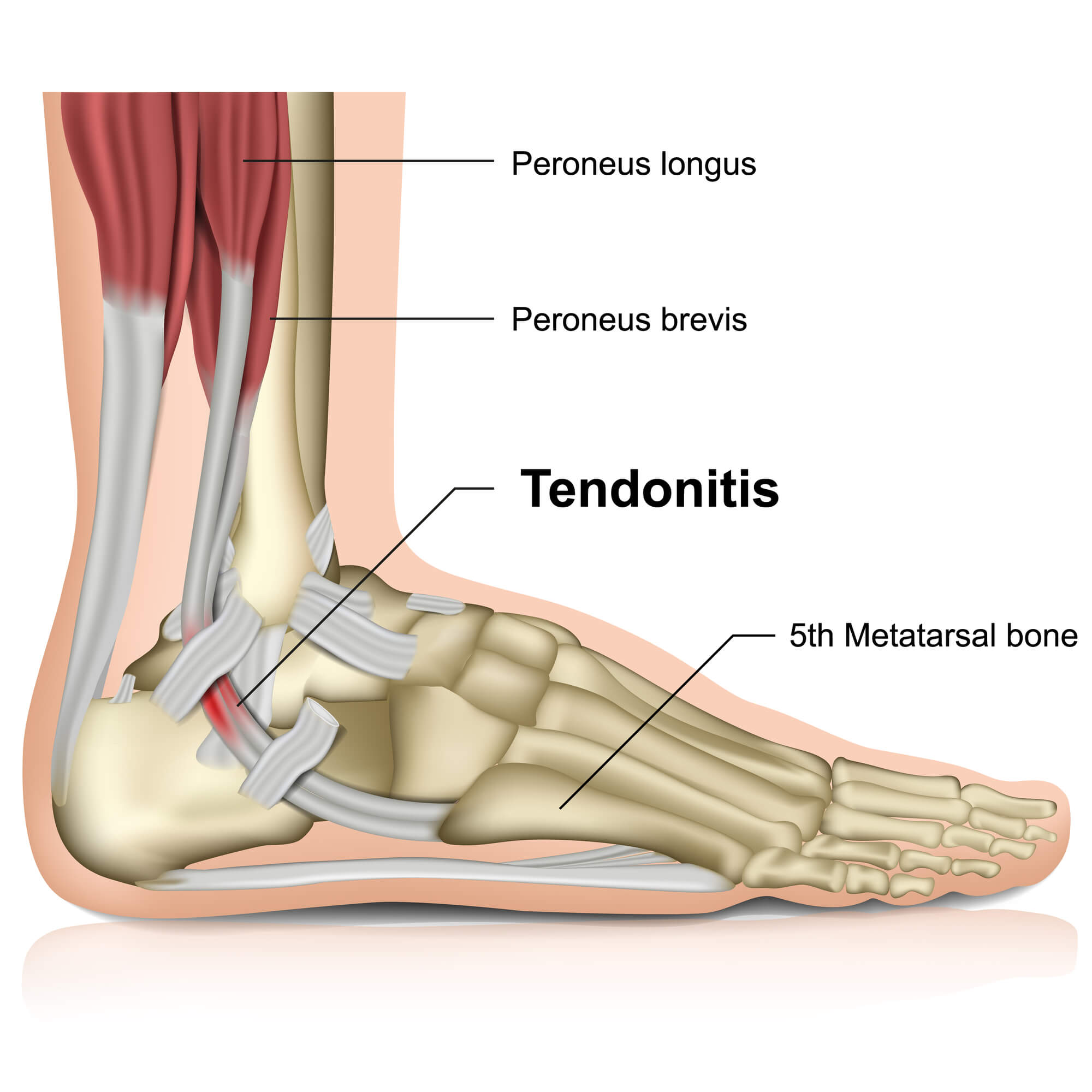Peroneal Tendonitis: Symptoms, Causes & Treatment
Peroneal tendonitis is an injury that affects the peroneal tendons located on the outside of the ankle. These tendons, which run along the fibula (the smaller of the two bones in the lower leg), are responsible for helping to turn the foot and stabilize the ankle. When the peroneal tendons become overworked or strained, they can inflamed and cause pain and discomfort.
Common Signs and Symptoms
The most common symptoms of peroneal tendonitis include pain and swelling on the outer ankle, tenderness when the ankle is moved, and difficulty walking or bearing weight on the affected foot. In some cases, the affected area may feel warm to the touch, and there may be a snapping or popping sensation when the foot is moved.

When to See a Doctor
If you suspect that you have peroneal tendonitis, it is important to see a podiatrist or other foot and ankle specialist for a proper diagnosis. This is especially important if the symptoms are severe or the pain and swelling do not improve with self-care measures. A podiatrist will be able to perform a physical exam, including an ultrasound, to confirm the diagnosis and rule out other potential causes of pain and swelling in the ankle.
Risk Factors
Several factors can increase the risk of developing peroneal tendonitis. These include:
- Repetitive ankle motions, such as those that occur during running or sports that involve cutting and turning
- Trauma or an ankle sprain
- Overuse of the peroneal muscles
- Tightness or weakness in the muscles of the lower leg
Injuries and Overuse
Peroneal tendonitis most commonly occurs due to overuse or repetitive motions that stress the peroneal tendons. This can happen during activities that involve a lot of running, jumping, or cutting and turning, such as basketball, soccer, or tennis.
Peroneal tendonitis can also occur due to a traumatic injury like an ankle sprain. This can happen when the ankle is twisted or turned unnatural, which can cause the tendons to stretch or tear.

Treatment
Non-surgical Treatment
The first line of treatment for peroneal tendonitis is typically non-surgical. This may include:
- Rest: It is important to take a break from the activity that caused the injury and avoid any activities that cause pain or discomfort.
- Ice: Applying an ice pack to the affected area can help to reduce pain and inflammation.
- Anti-inflammatory medication: Over-the-counter anti-inflammatory medications, such as ibuprofen, can be taken to help reduce pain and inflammation.
- Physical therapy: A physical therapist can teach you exercises to help strengthen the muscles of the lower leg and improve flexibility in the ankle.
Surgical Treatment
Surgery may be considered if non-surgical treatment is ineffective in reducing pain and inflammation. Surgery is typically only recommended for severe cases of peroneal tendonitis that have not responded to other forms of treatment. Surgery aims to repair or reconstruct the damaged tendon and can involve removing any damaged tissue, realigning the tendons, or reattaching the tendon to the ankle bone.
Physical Therapy and Rehabilitation
Physical therapy and rehabilitation are important parts of the treatment process for peroneal tendonitis. A physical therapist can work with you to develop an individualized rehabilitation program that includes exercises and stretches to help you regain strength and flexibility in your ankle and foot. This will help to prevent future injuries and improve your overall function.

Prevention
To help prevent peroneal tendonitis, it is important to protect your feet and ankles while participating in sports or other activities that stress these areas. Here are some tips to help prevent peroneal tendonitis:
- Warm up properly before participating in any physical activity.
- Wear supportive shoes that are appropriate for the activity you are doing.
- Strengthen the muscles of your lower leg and ankle with exercises such as calf raises and ankle rotations.
- Stretch your lower leg and ankle muscles before and after physical activity.
- Avoid increasing the intensity of your physical activity too quickly.
- Listen to your body and rest when you feel pain or discomfort in your ankle or foot.
Conclusion
Peroneal tendonitis is a common injury that affects the tendons on the outside of the ankle. Overuse, repetitive motions, or a traumatic injury such as an ankle sprain can cause it. Symptoms include pain and swelling on the outer ankle, difficulty walking, and tenderness when the ankle is moved. Treatment options include rest, ice, anti-inflammatory medication, physical therapy and rehabilitation, and in some cases, surgery. With the right treatment and preventative measures, it is possible to recover from peroneal tendonitis and return to normal activities.
FAQ
What is the fastest way to cure peroneal tendonitis?
The fastest way to cure peroneal tendonitis depends on the injury's severity and underlying cause. In general, the most effective treatment for peroneal tendonitis is a combination of rest, ice, anti-inflammatory medication, physical therapy, and rehabilitation. In some cases, surgery may be needed for severe cases of peroneal tendonitis.
What does peroneal tendonitis feel like?
The most common symptoms of peroneal tendonitis include pain and swelling on the outer ankle, tenderness when the ankle is moved, and difficulty walking or bearing weight on the affected foot. In some cases, the affected area may feel warm to the touch, and there may be a snapping or popping sensation when the foot is moved.
What makes peroneal tendonitis worse?
Peroneal tendonitis can be made worse by various factors, including overuse, repetitive motions, and trauma or injury. Factors such as tightness or weakness in the muscles of the lower leg and not properly warming up before physical activity can also contribute to the development of peroneal tendonitis.
How do I know if I have peroneal tendon damage?
If you suspect peroneal tendonitis, you must see a podiatrist or other foot and ankle specialist for a proper diagnosis. A podiatrist will be able to perform a physical exam, including an ultrasound, to confirm the diagnosis and rule out other potential causes of pain and swelling in the ankle.
Does walking make peroneal tendonitis worse?
Walking can aggravate peroneal tendonitis, especially if the injury is severe or in the early stages of healing. It is important to rest and avoid activities that cause pain or discomfort until the injury has improved. Once the pain and inflammation have decreased, a physical therapist can work with you to gradually increase your activity level in a controlled and safe manner.

